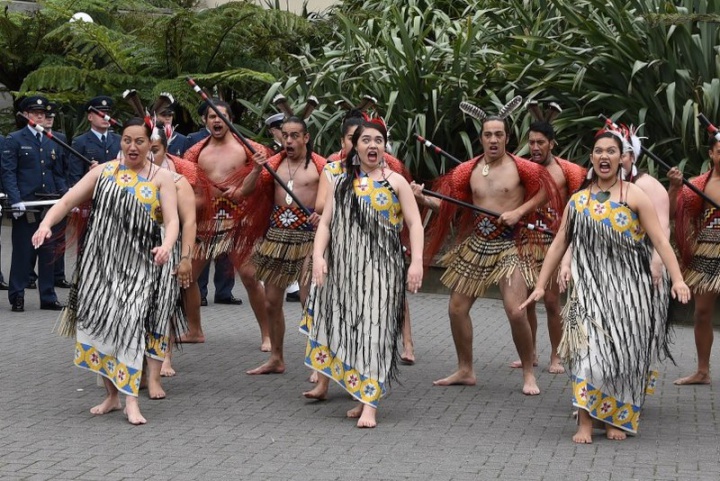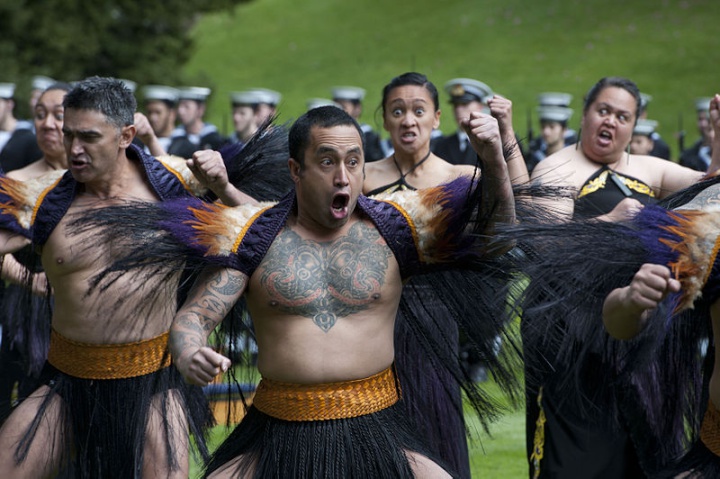The Haka: a Newcomer's Take on an Ancient Expression
The Haka: a Newcomer's Take on an Ancient Expression
by Grace Rader
Ka Mate haka of the All Blacks led by Richie McCaw before a match against France in 2006. Photo: Sonya & Jason Hills/Wikimedia Commons
Many newcomers to New Zealand are introduced to the haka—the ritualized Maori war dance—through YouTube videos of the All Blacks. Robust, thunder-chested men slap their open palms against thighs, biceps, and anything that reminds us that their muscles are bigger than ours.
When my mother first watched a televised performance from our suburban Nashville home, she was scared to say the least. The entire ritual seemed harsh and unnatural to her; like the dancers were insane and couldn’t control their actions. My sister had an opposite reaction: she couldn’t stop laughing at their facial expressions. She found the sincerity and seriousness of the entire situation as almost satiric. My father was just plain confused. He wondered about the purpose and effectiveness of what he witnessed. In my home state of Tennessee, we whoop it up for football games, but nothing like what we witnessed with the haka.
Landing in New Zealand for the first time, I was determined to trade video imagery for the real thing. I set out to witness a live performance and sit face-to-terrifying-face across from actual performers. What makes the haka an international curiosity and how do my family’s preconceptions mesh with reality? Those were the questions I aimed to answer. At the Auckland Museum I found my opportunity. Several times a day, Maori performers from the Ngāti Whātua tribe perform traditional songs and share their cultural heritage. The thirty-minute performance culminates in theater-shaking rendition of the haka.
I was terrified to see these massive men scream at the top of their lungs, beat their chests with such vigor that red handprints remain on their skin and make facial expressions I never thought possible. However, I couldn’t look away. Inspired, and still a bit shaken, I met the dancers after the show to discuss what I had witnessed and the sensations they inspired. The haka, they explained, is much more than just a fear-inducing dance. It incorporates the essence of nature, cognition, and the preparation for battle. The fluttering of hands mimics leaves in the wind or a bird flapping its’ wings. And the harsh beating of their bodies prepares them to endure strikes during battle.

Haka Powhiri at the swearing in of the 21st Governor-General of New Zealand The Rt Hon Dame Patsy Reddy, GNZM, QSO. Photo: Government House
Videos of the haka - as seen by my family and those distant in time and place - might seem silly and entertaining. When you are confronted with primal human expression in person, all reason leaves you. The haka is more than a fear-factor; it is a story of history and wisdom. My discussions with the dancers provided a clue as to the inspiration of their movement and power. Specifically, they shared that the idea of mana is central to the uniquely Polynesian expression that I witnessed.
I discovered that mana is not movement or a concrete object. It is energy and power that comes from the knowledge of who you are, where you are from, and your connection to the land around you. Mana grounds you and affirms your presence and rank in relation to those around you. It links you to your past, present, and future, and can be tested and challenged. Tame Iti, a member of the Tuhoe tribe, spoke at TEDx Auckland, providing an explanation of mana and its influence on non-Maori people. Tame Iti explained that mana is something you must be prepared to defend. More authority does not mean more mana. According to Tame Iti, “No one can tell you that your experience or knowledge is invalid.” If people are ignorant to the equalizer that is mana, it is important to “te ka nohi kit e ka nohi”-- translating as deal with it eye-to-eye.
Tame Iti explained that it is easy for someone to place themselves on a pedestal and champion untested beliefs; but when confronted with mana and the teachings of the elders, even the powerful are humbled and open to learning new things. For example, Tame Iti attended a meeting where an authority was on a stage answering questions and looking down at the people. Tame Iti brought a ladder so he could question them eye-to-eye. The power in knowing who you are is an immovable force and eternal source of strength.

Maori warriors perform a Haka, meaning dance of welcome, for Secretary of Defense Leon E. Panetta during a Powhiri ceremony while visiting Auckland, New Zealand Sept. 21, 2012. DoD photo by Erin A. Kirk-Cuomo
The All Blacks version of the haka is the subject of much discussion during the rugby season. As these men perform, viewers question the meaning of the movements, the origin of the dance, and more. By performing the haka, the All Blacks are planting seeds of curiosity about their culture around the world. The dance they perform is not simply a traditional war dance, but a dance that celebrates life over death.
As I met people with Maori heritage and spoke to them about the haka, I came to see the dance as a unifying force of the people; a sign of bravery and testament to courage. I am honored to have witnessed these ceremonies and pay homage to the art and culture of the Maori people. Mana is not just a part of a dance or an action; it is a way of life. And the haka is the ultimate expression of the way of the Maori.


 Ian Powell: Gisborne Hospital Senior Doctors Strike Highlights Important Health System Issues
Ian Powell: Gisborne Hospital Senior Doctors Strike Highlights Important Health System Issues Keith Rankin: Who, Neither Politician Nor Monarch, Executed 100,000 Civilians In A Single Night?
Keith Rankin: Who, Neither Politician Nor Monarch, Executed 100,000 Civilians In A Single Night? Eugene Doyle: Writing In The Time Of Genocide
Eugene Doyle: Writing In The Time Of Genocide Gordon Campbell: On Wealth Taxes And Capital Flight
Gordon Campbell: On Wealth Taxes And Capital Flight Ian Powell: Why New Zealand Should Recognise Palestine
Ian Powell: Why New Zealand Should Recognise Palestine Binoy Kampmark: Squabbling Siblings - India, Pakistan And Operation Sindoor
Binoy Kampmark: Squabbling Siblings - India, Pakistan And Operation Sindoor